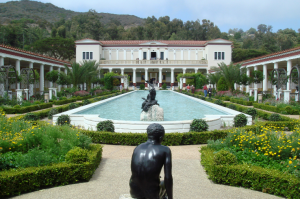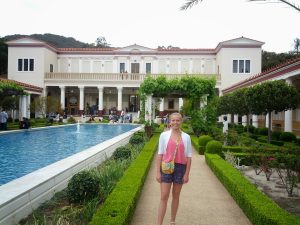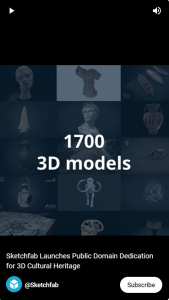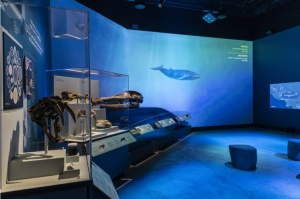12 Improving the Getty’s Educational Impact
Gracey INvestigates: how can The Getty be better?

what are the educational aims of The Getty?
Many of the harms caused by museums, especially their often illegal and immoral means of obtaining objects to display, are held in tension with their supposed educational benefit: providing a different type of learning experience for learners of all ages to connect with a given subject. Specifically, people often claim that a museum like the Getty is a great place for children to learn and create memorable experiences connected with historical and cultural information that can stay with them and possibly inspire a new interest. However, although this is a stated goal of the Getty, I have made it my mission to investigate this claim a little further. Is the current Getty Villa actually cultivating an environment that is engaging and educational to children? Are there ways that it could be better to actually achieve this goal? And, if there are ways it could be improved, what is holding them back from executing those improvements?
One bit of inspiration for this investigation is the comparison between the two visits I have made to the Getty Villa, in middle school and then again in this class. During my second visit it really struck me how little I was able to digest and engage with the material on my first visit. Even as a middle schooler, which seems like it should be an easier age for the educational aims of the museum to be effective, I still was generally unable to really get much of an educational experience out of my visit.

Me at the Getty (visit #1)
Learning Strategies
In order to investigate how museums could approach the goal of creating an effective educational environment, it is important to understand children’s developing brains and how they best relate to and understand new information. In Kinesthetic Learning in the Classroom, Joe Tranquilo writes that “as the brain matures, facts are abstracted and related to other concepts. Although the ability to abstract a concept and make complex connections between concepts are considered to be signatures of a mature mind, humans learn best by doing something concrete first, and then abstracting to more general concepts” [1]. Given this, it is important for museums to incorporate kinesthetic learning into any exhibits, if they wish to actually achieve their stated educational goals.
Additionally, not only would incorporating kinesthetic learning strategies in museums help children learn and absorb concepts better, it would also help people of all ages. In Ditching the Desks: Kinesthetic Learning in College Classrooms, Kayce Mobley & Sarah Fisher state that “as college instructors, [their] classrooms have benefited from incorporating kinesthetic learning activities generally reserved for secondary education settings” [2]. So incorporating more engaging exhibits that allow visitors to engage and physically interact should be prioritized as it would improve the learning experience of all visitors.
given this educational evidence, is the getty achieving their stated goals?
The Getty claims that a benefit of their exhibits is that it provides an educational space for students to learn and engage outside of the classroom. However, their exhibits are not currently designed in order to actually foster hands-on engagement. Having so many objects prevents learners, especially young ones, from actually being able to fully understand any of them. Additionally, the objects cannot be touched or interacted with in order to preserve them, but this also prevents learning through touching and interacting with physical objects.
how can The Getty be better and whats holding them back?
Ways to Improve
- 3D Models and decreasing reliance on original pieces
- Interactive exhibits to promote engagement with concepts and kinesthetic learning
I think this could be improved through the incorporation of 3D models and virtual reality exhibits that could allow visitors to actually engage with the material. I also think that the overwhelming quantity of objects at the Getty actually takes away from the ability to learn about each one. I think a much better design would be to instead have a few rooms that provide much more in depth information about a certain type of object and could have activities about how they were made, what they were used for, and how they relate to modern objects that visitors can relate to. Not only would this approach be more likely to actually achieve the educational goal, it would also decrease the culturally harmful practices of many museums including the Getty. By decreasing the overall amount of objects and also adding 3D objects and virtual reality activities museums would not be incentivized to take pieces from their countries of origin and give large sums of money to the looters who stole them.
Some examples of exhibits that I think could be helpful to implement or mirror:
Sketchfab has created an online collection of over 1600 3D models of objects from a variety of museums and cultural institutions that are free to view and interact with. I think that incorporating this online collection or a similar collection of virtual objects could be a great way for visitors to interact with objects without them being physically present.
The LA Natural History Museum as part of its LA Underwater exhibit, pictured below, has an interactive map that visitors can use to find fossils discovered near their neighborhood. This exhibit allows visitors to relate to the material and understand how they are connected to the concepts presented in the exhibit [3]. Additionally, the interactive aspect allow visitors to use their other senses and create more memorable experiences associated with the educational material presented in the exhibit.
I think that incorporating this idea to design an interactive experience to learn about the archeological process, the importance of context and preservation, and how archeologists use nearby or similar objects to date pieces could also be an educational addition that would both decrease reliance on importing objects and teach about the negative consequences of looting.
References:
[1] Tranquillo, Joe. “Kinesthetic Learning in the Classroom.” 2008 Annual Conference & Exposition Proceedings, https://doi.org/10.18260/1-2–3389.
[2] Mobley, Kayce, and Sarah Fisher. “Ditching the Desks: Kinesthetic Learning in College Classrooms.” The Social Studies, vol. 105, no. 6, 2014, pp. 301–309., https://doi.org/10.1080/00377996.2014.951471.
[3] “L.A. Underwater.” Natural History Museum, https://nhm.org/la-underwater.



